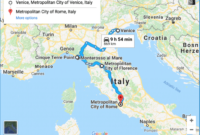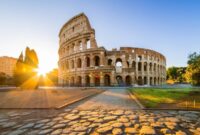Rome famous squares – Rome’s famous squares, steeped in history and cultural significance, form the vibrant tapestry of the Eternal City. From the iconic Spanish Steps to the grandeur of Piazza Venezia, each square tells a unique tale, inviting visitors to delve into the heart and soul of Rome.
As you traverse these storied piazzas, you’ll encounter architectural marvels, witness historical events unfold, and immerse yourself in the vibrant energy that has shaped Rome for centuries.
Introduction
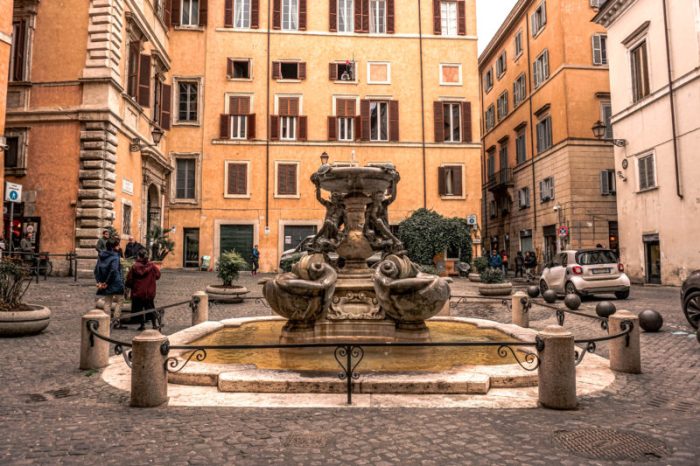
Rome’s famous squares are not just open spaces but also centers of social, political, and cultural life. These squares have witnessed centuries of history and have played a significant role in shaping the city’s identity.
From the ancient Roman Forum to the Renaissance-era Piazza Navona, each square has its own unique story to tell. They have been the sites of triumphs, celebrations, and revolutions. They have also been used for public executions and religious ceremonies.
Historical Significance
The Roman Forum was the heart of ancient Rome. It was here that the city’s political, religious, and commercial life took place. The Forum was also the site of some of Rome’s most important buildings, including the Senate House, the Temple of Jupiter, and the Arch of Titus.
The Piazza Navona was built in the 15th century on the site of an ancient Roman stadium. The square is home to three beautiful fountains, including the famous Fontana dei Quattro Fiumi (Fountain of the Four Rivers) by Bernini.
Cultural Impact
Rome’s squares have also been important centers of culture. The Piazza di Spagna is home to the Spanish Steps, one of the most popular tourist attractions in Rome. The square is also a popular spot for artists and musicians.
The Piazza del Popolo is home to the Porta del Popolo, one of the main gates of Rome. The square is also a popular spot for concerts and other events.
Piazza Navona
Piazza Navona is one of the most famous and beautiful squares in Rome, Italy. It has a unique oval shape and is surrounded by stunning Baroque architecture. The square is home to three beautiful fountains, including the Fontana dei Quattro Fiumi (Fountain of the Four Rivers) by Bernini, which is considered one of the most iconic fountains in the world.
Fontana dei Quattro Fiumi (Fountain of the Four Rivers)
The Fontana dei Quattro Fiumi is the centerpiece of Piazza Navona. It was designed by Gian Lorenzo Bernini and completed in 1651. The fountain depicts four river gods, each representing one of the four major rivers of the world: the Nile, the Ganges, the Danube, and the Rio de la Plata.
The fountain is a masterpiece of Baroque art and is one of the most famous fountains in the world.
Historical and Cultural Events, Rome famous squares
Piazza Navona has been the site of many historical and cultural events over the centuries. In the 16th century, the square was used for bullfights and other public spectacles. In the 19th century, the square was used as a market.
Today, Piazza Navona is a popular tourist destination and is often used for concerts, art exhibitions, and other events.
Piazza di Spagna
Nestled in the heart of Rome’s historical center, Piazza di Spagna exudes an enchanting blend of architectural grandeur and vibrant street life. The iconic Spanish Steps serve as a focal point, connecting the square to the Pincian Hill, while the captivating Fontana della Barcaccia adds a touch of whimsy and artistic charm.
Rome is renowned for its captivating squares, each boasting a unique charm and historical significance. From the bustling Piazza Navona to the serene Campo de’ Fiori, these squares offer a glimpse into the city’s rich past. To delve deeper into the allure of Rome, consider planning a trip to visit rome , where you can immerse yourself in the city’s vibrant culture and explore its famous squares at your own pace.
The Spanish Steps
The monumental Spanish Steps, comprising 135 travertine steps, ascend from the base of the square to the summit of Pincian Hill. Constructed in the 18th century, these steps have become an integral part of Roman culture, hosting countless gatherings, fashion shows, and artistic performances.
Fontana della Barcaccia
At the foot of the Spanish Steps lies the intriguing Fontana della Barcaccia, or “Fountain of the Sunken Boat.” Designed by Pietro Bernini in the 17th century, this unique fountain depicts a half-submerged boat overflowing with water. Its unusual design is said to symbolize the devastating flood that struck Rome in 1598.
Fashion and Shopping
Piazza di Spagna is renowned for its upscale fashion and shopping scene. The surrounding streets are lined with boutiques, designer showrooms, and luxury brands, catering to discerning shoppers seeking the latest trends and exclusive pieces.
Piazza del Popolo: Rome Famous Squares
Piazza del Popolo has played a pivotal role as the grand gateway to Rome since ancient times. Originally known as “Porta Flaminia,” it marked the end of the Via Flaminia, a major consular road connecting Rome to the Adriatic coast.
Rome is a city full of history and culture, and its famous squares are no exception. From the bustling Piazza Navona to the serene Piazza del Popolo, these squares are a great place to soak up the atmosphere of the city.
If you’re wondering where Rome is, it’s located in central Italy, about 150 miles north of Naples. To learn more about the location of Rome, you can visit where is rome . Back to Rome’s famous squares, they are a must-see for any visitor to the city, and they’re sure to leave a lasting impression.
The square’s iconic centerpiece is an ancient Egyptian obelisk, originally from the Temple of Ramses II in Heliopolis. It was brought to Rome by Emperor Augustus in 10 BC and erected in the Circus Maximus. In 1589, Pope Sixtus V had it moved to its current location in Piazza del Popolo.
Twin Churches
Flanking the obelisk are two nearly identical churches, Santa Maria del Popolo and Santa Maria in Montesanto. Santa Maria del Popolo was built in the 11th century and later remodeled by Bernini in the 17th century. It houses famous works of art, including Caravaggio’s “Conversion of Saint Paul” and “Crucifixion of Saint Peter.”
Santa Maria in Montesanto was built in the 17th century and is known for its unusual elliptical shape. It features a façade adorned with statues of saints and a clock that chimes every hour.
Piazza Venezia
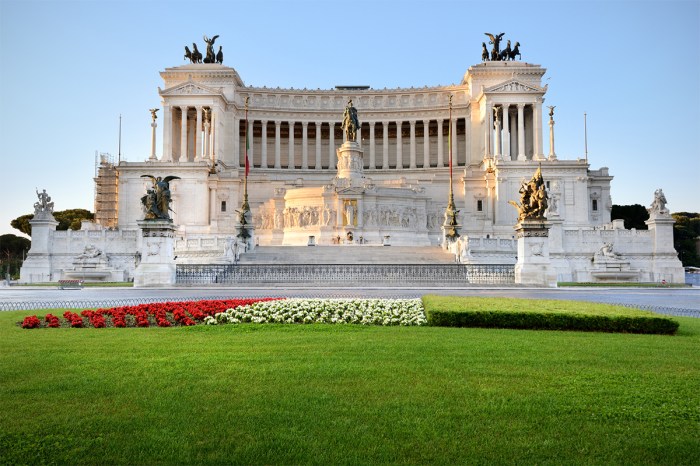
Piazza Venezia, one of Rome’s most iconic squares, is a testament to the city’s architectural grandeur and historical significance. Dominating the square is the imposing Altare della Patria (Altar of the Fatherland), a monument dedicated to Italy’s first king, Victor Emmanuel II.
Architectural Marvels
Surrounding the square are several impressive buildings that showcase different architectural styles. The Palazzo Venezia, built in the 15th century, is a masterpiece of Renaissance architecture. The Palazzo Bonaparte, once the residence of Napoleon’s mother, is an example of Neoclassical design.
The Protomoteca, built in the 19th century, is a neo-Renaissance building that houses the Capitoline Museum’s collection of busts and statues.
Altare della Patria
The Altare della Patria is the centerpiece of Piazza Venezia. This colossal white marble monument, inaugurated in 1911, symbolizes Italian unity and commemorates the sacrifices made during the Risorgimento, Italy’s unification movement.
The monument features a massive central staircase leading to a colonnaded portico. The interior houses the Tomb of the Unknown Soldier, a symbolic resting place for an unidentified Italian soldier who died in World War I.
Political and Cultural Hub
Piazza Venezia has been a central location for political and cultural events throughout history. It has witnessed numerous rallies, demonstrations, and public gatherings. The square is also a popular tourist destination, attracting visitors from around the world who come to admire its architectural beauty and historical significance.
Piazza della Rotonda
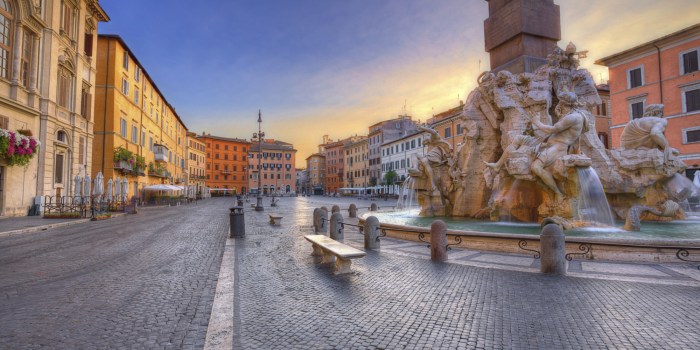
Piazza della Rotonda is a captivating square in Rome, renowned for its architectural marvel, the Pantheon. This ancient temple, with its awe-inspiring dome, stands as a testament to Roman architectural prowess.
The Pantheon
The Pantheon, commissioned by Emperor Hadrian and completed in 126 AD, is an architectural masterpiece. Its iconic dome, the largest unreinforced concrete dome ever built, spans an astonishing 43.3 meters in diameter. The oculus, a circular opening at the dome’s apex, floods the interior with natural light, creating an ethereal ambiance.
Piazza as a Gathering Place
Piazza della Rotonda serves as a vibrant gathering place for locals and tourists alike. The square’s picturesque setting, surrounded by historic buildings and bustling cafes, invites people to linger and soak up the atmosphere.
Cafes and Restaurants
The piazza is lined with charming cafes and restaurants, offering a range of culinary delights. Visitors can savor authentic Italian cuisine, sip on espresso, or indulge in gelato while admiring the grandeur of the Pantheon.
Final Thoughts
Rome’s famous squares stand as enduring testaments to the city’s rich past and vibrant present. They are not merely physical spaces but living, breathing entities that have played a pivotal role in shaping the Roman experience. As you explore these iconic piazzas, let their timeless allure transport you to another era, where history, culture, and the indomitable spirit of Rome intertwine.
